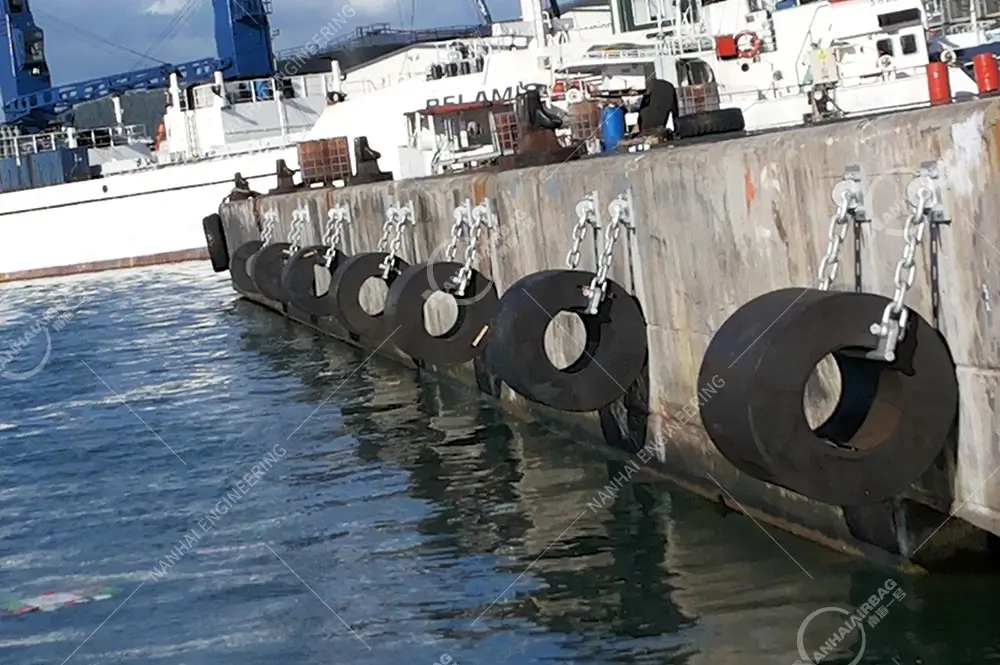Qu'est-ce qu'un garde-boue en composite ?
07/31/2025Qu'est-ce que le transfert de GNL de navire à navire ?
08/04/2025En quel matériau les ailes en caoutchouc sont-elles fabriquées ?
Pourquoi c'est important - et pourquoi maintenant :
Imaginez que vous amarriez votre navire dans un port très fréquenté et que vous entriez en contact avec un quai en béton. Un impact en une fraction de seconde sans le tampon adéquat peut vous laisser avec des dommages structurels coûteux ou des rayures sur la coque, sans parler du temps d'immobilisation et des coûts de réparation. À NANHAÏNous comprenons à quel point le choix des garde-boue est de protéger vos actifs et vos opérations. Avec l'augmentation du trafic maritime mondial et la pression exercée sur les infrastructures portuaires, il est plus urgent que jamais de trouver les bonnes défenses.

Snippet en vedette : Réponse rapide
Les fabricants utilisent généralement des composés de caoutchouc naturel ou synthétique de haute qualité, tels que le caoutchouc naturel mélangé à du SBR, de l'EPDM, du néoprène ou du nitrile, pour fabriquer des produits en caoutchouc. ailes en caoutchouc. Ces composés offrent une excellente élasticité, une résistance aux UV et à l'eau de mer, ainsi qu'une forte absorption d'énergie - parfaits pour les applications marines lourdes.
Plongée en profondeur : Les matériaux Fender en pratique
- Caoutchouc naturel / SBR: Souvent utilisé dans les profilés extrudés ou moulés tels que les ailes en D, les cellules et les cônes. Offre une grande résistance à la traction, à la déchirure et à la flexibilité.
- caoutchouc EPDM: Elastomère synthétique très résistant aux intempéries, à l'ozone, aux rayons UV et aux variations de température. Idéal pour les installations à quai exposées.
- Néoprène ou NBR (nitrile): Utilisé lorsqu'une résistance aux huiles, aux carburants ou aux produits chimiques est nécessaire. Offre une absorption ferme mais souple des chocs dans les environnements exposés aux produits chimiques.
- Défenses pneumatiques (remplies d'air): Construit à partir de plusieurs couches de feuilles de caoutchouc synthétique renforcées par des cordes enveloppés et vulcanisés ensemble. Solide, élastique et adapté à l'amarrage de navire à navire et à l'amarrage en mer.
- Défenses en mousse élastomère: Souvent en mousse de caoutchouc à cellules fermées (latex synthétique ou naturel/PUR), parfois enveloppée d'une peau plus résistante. Léger, flottant et nécessitant peu d'entretien.
FAQ
- Quelle est la différence entre les défenses en caoutchouc et les défenses en mousse ?
Les défenses en caoutchouc offrent une durabilité supérieure, une absorption d'énergie et une résistance à l'eau salée, aux UV et à l'abrasion, ce qui les rend adaptées à une utilisation intensive et à long terme. Les défenses en mousse sont plus légères, flottantes et plus simples à installer, mais elles peuvent s'user plus rapidement dans des environnements difficiles.
- De quoi sont faites les défenses marines pneumatiques ?
Ils sont fabriqués à partir de feuilles de caoutchouc synthétique renforcées et recouvertes de cordes, conçues pour retenir l'air sous pression. Ils sont donc très élastiques et conviennent aux environnements à fort impact tels que les transferts de navire à navire.
- Quel est le composé de caoutchouc qui résiste le mieux aux UV et aux intempéries ?
Les ingénieurs choisissent le caoutchouc EPDM pour sa résistance exceptionnelle aux UV, à l'ozone, aux variations de température et aux conditions extérieures difficiles.
- Les défenses marines en caoutchouc sont-elles toutes fabriquées à partir des mêmes matériaux ?
Les différents types de garde-boue utilisent des composés de caoutchouc différents. Par exemple, les garde-boue de type D ou cellulaire utilisent souvent du caoutchouc naturel/SBR. L'EPDM fonctionne bien dans les zones exposées aux UV, tandis que le néoprène ou le nitrile est le meilleur choix pour la résistance aux carburants.
Comment NANHAI établit la norme
Au NANHAÏEn outre, nous ne nous contentons pas d'utiliser des mélanges de caoutchouc standard : nous renforçons nos défenses en caoutchouc avec plusieurs brins de câbles de pneu synthétiques (généralement trois ou plus) pour une résilience inégalée. Nous adaptons le matériau et la forme - qu'il s'agisse d'une défense en D extrudée solide ou d'un tampon pneumatique de navire à navire - afin de fournir une absorption d'énergie optimale, de prolonger la durée de vie et de vous donner une tranquillité d'esprit.
Réflexions finales
Il ne suffit pas de choisir un composé de caoutchouc, qu'il s'agisse de caoutchouc naturel/SBR, d'EPDM, de néoprène/NBR ou de caoutchouc renforcé par de la mousse, il faut aussi prendre une décision en matière de performance. Il s'agit de protéger les actifs, de minimiser la maintenance à long terme et de garantir un accostage sûr et efficace à chaque fois. Avec des décennies d'expérience, NANHAÏ garantit que votre défenses correspond à votre navire, aux conditions et aux besoins de durée de vie. Contactez-nous pour concevoir votre solution idéale.
